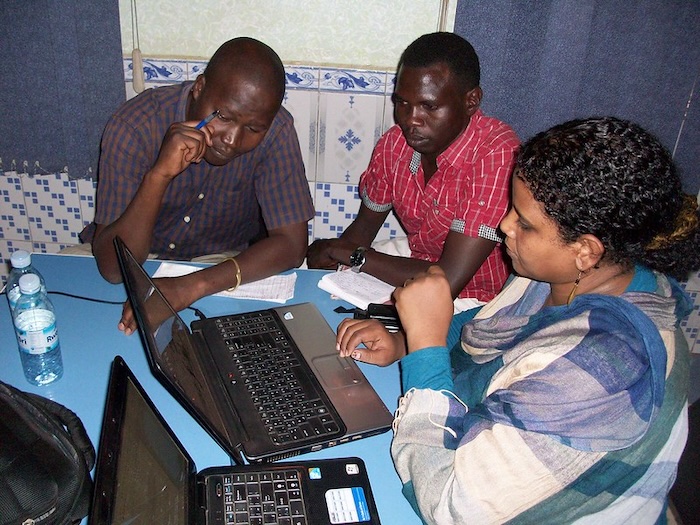 A list of sustainable business models for media managers who are planning to start a media outlet in economically challenging circumstances.
A list of sustainable business models for media managers who are planning to start a media outlet in economically challenging circumstances.
Running a news business is hard. Paying for public service journalism is a major challenge. The old business model, based mainly on advertising, has collapsed.
Many news operations have folded under the intense financial pressure – but others have survived and new providers have sprung up, with creative approaches to funding.
Here we list some of the ways that news providers have developed in order to survive.
Media Helping Media has been involved in projects around the world that used some of these new approaches. Others are listed with the help of AI.
The aim is to provide a guide for independent media to use and adapt to their own economic environment, to deliver sustainability.
Each model comes with a step-by-step guide to implementation.
Paywall
A paywall media organisation is a media company, such as a newspaper, magazine, or streaming service, that restricts access to its online content through a paywall, requiring users to make a purchase, often in the form of a paid subscription or membership, to view the full content. This model is primarily used to generate revenue to support the creation of content, especially as traditional advertising revenue for media has declined in the digital age.
Examples
The New York Times utilises a metered paywall, allowing users to read a set number of free articles per month before requiring a paid digital subscription for unlimited access. This model aims to convert heavy users into paying subscribers while keeping a wide readership base for advertising revenue.
Revenue-generation package:
- Reader revenue (digital, print, bundled)
- Advertising (digital and print)
- Other (content licensing, affiliate links, live events)
Step-by-step:
- Build the foundation:
- Install a soft meter:
- Create the first paid product:
- Offer a premium email newsletter featuring behind-the-scenes reporting, Q&A (questions and answers) with reporters, or early access to major stories.
- Price it modestly relative to the local economy.
- Monetise non-paywalled pages:
- Sell digital ad slots (Google Ad Manager, BuySellAds) on free content.
- Approach local businesses directly for native sponsorships (“This story series supported/sponsored by…”).
- Track and adjust:
- Monitor metrics: free article completion rates, newsletter signups, and subscription conversions.
- Tighten the meter (for example five free articles) only after consistent growth.
Pitfall to avoid:
Introducing a paywall before you have regular readers — build engagement first.
Voluntary membership
A voluntary membership media organisation is a non-profit with its existence and operations primarily fuelled by the voluntary participation and financial contributions of its members. Unlike commercial media, its main purpose isn’t to generate profit for owners but to serve a collective interest, which often involves advocating for journalistic standards and press freedom, supporting media professionals through a professional association, or operating local, community-focused media outlets. Control and governance of the organisation typically rest with its membership, who join by choice to support its mission.
Example
The Guardian Media Group operates the UK newspapers The Guardian and The Observer, but its ultimate owner is the Scott Trust, a non-profit body. This unique structure legally mandates that all profits be reinvested to fund the paper’s journalism and secure its editorial independence, effectively insulating it from commercial or political pressure. Instead of a hard paywall, The Guardian relies heavily on a voluntary contribution/membership model, asking readers worldwide to donate or subscribe to its app to support its mission of free, high-quality, investigative journalism that serves the public interest.
Revenue-generation package:
- Reader contributions
- Digital advertising and sponsorships
- Print and app subscriptions
- Hardcopy sales at newsagents
Step-by-step:
- Define and publish your mission:
- Write a one-paragraph “Why we exist” statement and display it on your homepage and donation pages.
- Example: “We are an independent newsroom telling stories that matter to our community — free for all, funded by readers.”
- Launch the ‘soft ask’:
- Add a “Support us” button on every page, linking to a lightweight donation tool (for example, Ko-fi, Patreon, or OpenCollective).
- Keep the appeal personal — use the editor’s photo or a direct thank-you note.
- Activate local advertising:
- Approach 10–15 businesses for display or social ads.
- Offer introductory rates or barter (ads in exchange for event space or catering).
- Recognise and retain members:
- Publicly thank early supporters.
- Send exclusive updates, early previews, or small “supporter-only” perks like stickers or merchandise.
- Build transparency:
- Publish short quarterly updates on how funds were used to show accountability.
Pitfall to avoid:
Avoid guilt-based appeals (“support us or we disappear”). Inspire participation, not obligation.
Philanthropic
A philanthropic media organisation is a non-profit news entity whose operations and public-interest journalism are primarily financed through grants and donations from charitable foundations, individual philanthropists, and corporate giving, rather than relying on advertising or commercial revenue. This funding model allows the organisation to focus on producing in-depth, civic-minded content – such as investigative reporting or local news – that is essential for the public good but may be too costly or commercially unviable for traditional for-profit media, thereby ensuring its editorial independence is anchored to its public service mission.
Example
ProPublica is a globally recognised, non-profit newsroom that specialises in investigative journalism in the public interest. It was one of the pioneers of the modern philanthropic journalism movement, being largely financed by major foundations and individual donors. Its funding model allows it to undertake costly, time-intensive investigations – often on issues of government and corporate abuse – that commercial newsrooms may avoid due to the lack of a clear return on investment. The organisation frequently partners with traditional media outlets, sharing its work to maximise public impact while maintaining full editorial control, anchored solely to its public service mission.
Revenue-generation package:
- Foundation grants
- Individual donors
- Co-publishing/licensing
Step-by-step:
- Identify your first ‘impact story’:
- Choose one public-interest area (for example, housing, environment, corruption).
- Outline what measurable impact success would look like (for example, policy change, public awareness).
- Find matching grants:
- Search databases such as IJNet, Journalismfund.eu, or Media Impact Funders or grants aligned with your focus.
- Apply for small pilot grants first.
- Launch a transparent donor drive:
- Diversify:
- Aim for no more than 50% of your income from one foundation.
- Build multiple small partnerships rather than relying on a single donor.
- Track everything:
- Document your process, impact, and spending for transparency and future applications.
Pitfall to avoid:
Relying entirely on grants for general operations — funders prefer project-based support.
Cooperative ownership
A cooperative ownership media organisation is a media entity – such as a newspaper, news website, or radio station – that is jointly owned and democratically controlled by its members under the principle of “one member, one vote,” regardless of their financial stake. These members can be the workers (journalists and staff), the consumers (readers or listeners), or a combination of different stakeholders (a multi-stakeholder co-op). The co-op model contrasts with for-profit media by prioritising its mission and the collective interests of its community over external investor profit, aiming to ensure greater editorial independence, public accountability, and a focus on local or underserved public interest issues.
Example
The Bristol Cable is a prominent example of a UK-based, hybrid media cooperative. It is legally structured as a Community Benefit Society (CBS), meaning its assets are locked for the public good and it is jointly owned by a mixture of its readers and its staff. Reader-members pay a small monthly fee and have a democratic voice, including the right to vote on the organisation’s strategy and elect a majority of the board, which keeps the journalism accountable to the local community. Simultaneously, the staff operates as a worker cooperative, giving the journalists and editors a direct, collective say in the running of the newsroom, fundamentally embedding public interest into its governance.
Revenue-generation package:
- Member economic participation
- Advertising and sponsorship
- Grants, donations, and events
Step-by-step:
- Register a cooperative:
- Use a legal form such as a “Community Benefit Society” (UK) or “Cooperative Corporation” (US).
- Each member has one vote, regardless of contribution.
- Launch a founding member drive:
- Offer lifetime or annual memberships for a price appropriate to the local economy.
- Give members voting rights on editorial priorities.
- Run member meetings:
- Quarterly town halls to discuss coverage focus and transparency.
- Develop core content pillars:
- Focus on issues the community identifies as top priorities (for example, housing, environment, education).
- Show collective impact:
- Publish yearly “Member reports” detailing outcomes and finances.
Pitfall to avoid:
Letting governance overwhelm journalism — start lean and evolve participation gradually.
Crowdfunding
A crowdfunding media organisation raises funds from a large number of individuals through online platforms for specific projects, start-up costs, or ongoing operations. This model allows media outlets to mobilise community support upfront without relying on traditional advertising or subscription revenue. It is particularly useful for launching new outlets or funding investigative projects with explicit objectives and timelines.
Example
De Correspondent in the Netherlands started as a crowdfunded platform focused on membership journalism, raising initial capital from thousands of supporters to launch its independent, in-depth reporting model. Crowdfunding provided early financial resources and community engagement before other revenue streams matured.
Revenue-generation package:
- One-time or recurring public contributions via crowdfunding platforms
- Membership conversions post-campaign
- Potential follow-on donor support or subscriptions
Step-by-step:
- Define your project or launch goal clearly with a compelling narrative and target amount.
- Choose a crowdfunding platform suited to media projects (e.g., Kickstarter, Indiegogo, GoFundMe).
- Create engaging multimedia pitches, including explainer videos and journalist testimonials.
- Offer tiered rewards or recognition levels to incentivise backers (for example, early access, exclusive content).
- Promote the campaign widely across social media, partner organisations, and email lists.
- Keep backers informed throughout the campaign and post-completion with transparent updates.
Pitfall to avoid:
Underestimating the marketing effort required to meet funding goals and failing to deliver promised rewards promptly.
Hybrid nonprofit–commercial model
A hybrid nonprofit–commercial media organisation is a structured entity that combines the mission-driven public service values of a nonprofit with the revenue-generating capabilities of a commercial business. This model typically involves a nonprofit core focused on civic-minded journalism (often funded by grants and donations) that operates alongside a separate, for-profit subsidiary or commercial arm. The for-profit arm generates earned revenue through activities such as advertising, paid services, or events, and then channels those profits back to support the mission-driven, tax-exempt journalistic work of the nonprofit core. This structure is designed to secure financial stability and greater scale for public interest reporting while maintaining editorial independence from any single funding source.
Example
The Korea Center for Investigative Journalism (KCIJ), runs the news site Newstapa; while KCIJ is primarily a nonprofit sustained by membership donations to ensure editorial independence, it achieves financial resilience (hybridity) by generating earned income through commercial activities such as licensing its award-winning investigative journalism to other media outlets and hosting exclusive, ticketed events for its members.
Revenue-generation package:
- Reader memberships
- Philanthropic grants
- Sponsorships
- Live events and conferences
- Commercial services
Step-by-step:
- Separate income streams clearly:
- Define “mission” activities (news, investigations) and “commercial” activities (events, data services).
- Create separate budget lines for each to avoid confusion with donors.
- Start with philanthropy:
- Secure one or two small foundation or civic grants to fund journalism that aligns with public interest (education, accountability, or transparency).
- Add a commercial arm early:
- Run sponsored events, paid data reports, or training sessions for local institutions or NGOs.
- Example: “Media skills for nonprofits” workshops.
- Develop a membership base:
- Offer free signups initially; convert later to paid members with benefits like early access to stories or event discounts.
- Showcase impact publicly:
- Maintain a “Supporters and impact” page showing how different revenue streams sustain independent journalism.
Pitfall to avoid:
Mixing donor money and commercial advertising in the same projects — donors value transparency above all else.
Content syndication & partnerships
A content syndication & partnerships media organisation generates revenue and expands its reach by licensing its proprietary articles, video footage, photographs, or data to other platforms, publishers, and companies, often for a negotiated fee or a share of the advertising revenue. This business model allows the organisation to monetise its existing intellectual property multiple times by granting non-exclusive or exclusive rights to third parties – such as news aggregators, corporate databases, or international media outlets – who want to use high-quality, trusted content to supplement their own offerings, in order to diversify the original content creator’s income beyond its primary advertising or subscription base.
Example
The Associated Press (AP) operates as a global nonprofit news cooperative owned by its member newspapers and broadcasters. The AP’s core function is not to publish directly to the public, but to generate a constant stream of authoritative news content – including text, photos, and video – which is then syndicated and licensed to thousands of subscribing media partners across the globe. This partnership model allows media outlets to consistently fill their news output with national and international reporting that would otherwise be cost-prohibitive, making content syndication the essential mechanism that funds the AP’s global journalistic operations.
Revenue-generation package:
- Licensing content
- Partner fees
- Shared production grants
Step-by-step:
- Identify potential partners:
- Local radio stations, small digital outlets, or civic blogs who could benefit from your reporting.
- Standardise your content:
- Produce clean, reusable formats — for example, text + image packages or short audio segments.
- Offer free trials:
- Share select stories freely to prove quality.
- Include credit line and link back to your site.
- Create subscription tiers:
- Example:
- $0: Occasional story exchange
- $50/month (or whatever is appropriate in the local economy): Full access to weekly content package
- Example:
- Build collaborative grants:
- Apply jointly with partners for cross-outlet grants (for example, investigative or regional projects).
Pitfall to avoid:
Underpricing your work. Establish clear licensing terms and value your intellectual property.
Newsletter-centric model
A newsletter-centric media organisation prioritises the distribution of proprietary content directly to the user’s inbox via email as its primary product and revenue channel. This model leverages the high engagement, direct relationship, and low technical overhead of email to build a highly dedicated and easily identified audience. Revenue is typically generated through a mix of premium paid subscriptions, embedded native advertising/sponsorships within the email itself, or affiliate marketing. This approach is highly effective for niche topics, personality-driven journalism, and markets where a full, complex website is too costly to maintain.
Example
Substack is a leading platform that hosts thousands of individual journalists and media brands who use the newsletter-centric model. It allows writers to create, distribute, and monetise a newsletter, often offering a free tier alongside a paid subscription tier for exclusive articles, analysis, or community features. By bypassing traditional publishing infrastructure, it empowers individual journalists or small teams to quickly launch and scale a profitable, niche media outlet with a direct, personal connection to their readers.
Revenue-generation package:
- Premium subscriptions (the primary revenue source for exclusive content)
- Native advertising/sponsorships (advertiser embeds directly within the email)
- Affiliate links (product recommendations)
- Crowdfunding/tips (voluntary contributions)
Step-by-step:
- Define your niche & persona:
- Choose a single, specific topic (for example, local zoning, a specific sport, or political accountability).
- The tone must be personal – the writer’s voice is the brand.
- Choose a distribution platform:
- Use a platform designed for paid email (for example, Substack, Ghost, or Kit – formerly ConvertKit).
- Establish a free-to-paid ratio:
- Publish 80% of content to a free, public list to build trust and the audience funnel.
- Reserve 20% of your best, most exclusive analysis for the paid tier.
- Monetise the free tier:
- Secure one or two anchor sponsors, such as local businesses, niche software, to embed a small native ad/banner at the top or bottom of every free edition.
- Pitch the paid product:
- In the free newsletter, include a short, explicit pitch for the paid content at least once per week. Show readers exactly what they are missing.
- Track and engage:
- Monitor open rates and click-through rates.
- Directly respond to reader emails—this personal touch builds loyalty essential for subscription retention.
Pitfall to avoid:
Treating the newsletter like a website feed – the content must be concise, conversational, and designed to be read quickly in an inbox, not just an HTML page dump.
Social enterprise
A social enterprise media organisation operates with a defined social mission, reinvesting profits into social objectives such as community development, media literacy, or journalist training. It balances commercial activities with impact goals, often crossing traditional nonprofit and business structures. Social enterprise status can unlock grant funding, impact investment, or government support unavailable to pure commercial outlets.
Example
The Bureau Local in the UK operates as a social enterprise, supporting local investigative journalism through a combination of grants, services, and training while reinvesting any profits to grow its public interest journalism network.
Revenue-generation package:
- Earned income from service contracts or training
- Grants and impact investment geared toward social outcomes
- Membership fees or donations aligned with mission
- Events and workshop fees
Step-by-step:
- Clarify your social mission and document how your media activities generate social benefit.
- Choose an appropriate legal form fitting social enterprise criteria in your jurisdiction.
- Develop a mixed revenue model combining commercial services and mission-aligned funding.
- Communicate impact regularly to stakeholders, using social metrics alongside financials.
- Seek partnerships with social investors, foundations, or government programmes supporting social enterprises.
- Build capacity gradually, balancing business discipline with social objectives.
Pitfall to avoid:
Losing focus by over-emphasising commercial revenue at the expense of mission-driven goals.
Micro-payments
A micro-payments media organisation uses technology to enable consumers to pay small amounts for individual pieces of content, such as single articles, videos, or podcasts. This allows casual or occasional users to support media without full subscriptions, broadening access while still monetising content directly. It’s a flexible alternative to subscriptions especially suited to digital and mobile-first markets.
Example
Axate is a UK-based digital wallet system that enables readers to pay small amounts for individual articles across multiple participating news websites. Instead of committing to a full subscription, users create a single Axate account, add funds once, and then use that balance to access paywalled content wherever Axate is integrated. This system allows publishers to monetise casual or occasional readers who might not otherwise subscribe, while giving audiences a seamless and flexible way to support quality journalism. By reducing payment friction and encouraging cross-site use, Axate aims to create a sustainable micro-payment ecosystem for digital media.
Revenue-generation package:
- Transaction fees on micro-payments
- Publisher partnerships
- Reader wallet balances
- Data and audience insights
- Cross-site engagement
Step-by-step:
- Define your value proposition – identify the type of content you will offer — news, features, investigations, opinion, video, podcasts, etc.
- Understand your audience – research your audience segments: who they are, how often they consume your content, and what their willingness to pay is.
- Choose or build your payment platform – partner with Axate directly or develop your own micro-payment system using similar principles.
- Design a tiered access strategy – combine free access for casual browsing with paid unlocks for premium or in-depth stories.
- Set up pricing and incentives – start with low friction pricing — then offer bundles or loyalty incentives
- Integrate seamless user experience – minimise barriers: let users read the first few paragraphs before prompting payment
- Measure, analyse, and adapt – track metrics such as conversion rate (free to paid), average revenue per reader, retention and repeat purchases, article performance (what drives payments)
- Build trust and transparency – Communicate clearly how reader payments sustain your newsroom. Offer guarantees (for example, refunds for accidental purchases) and keep the process user-friendly. Transparency helps turn one-time buyers into loyal supporters.
Pitfall to avoid:
Relying on micro-payments without generating enough repeat engagement, leading to low transaction volumes that fail to produce sustainable revenue.
Branded content / Native advertising
A branded content or native advertising media organisation generates revenue by producing sponsored content that aligns with advertisers’ marketing goals but is integrated in a way that complements editorial style and reader experience. Unlike traditional ads, these pieces often tell stories or provide useful information connected to the sponsor’s brand, while maintaining journalistic ethics and clear labelling. This balances commercial needs without compromising content credibility.
Example
The Quartz media outlet has a branded content studio creating in-depth sponsored articles and series for major corporate clients, carefully integrating brand messaging with editorial storytelling to reach engaged audiences.
Revenue-generation package:
- Sponsored content production fees
- Long-term partnerships with advertisers/brands
- Content licensing or co-branding deals
Step-by-step:
- Establish internal guidelines ensuring transparency and ethical labelling of sponsored content.
- Work with advertisers to identify content themes that fit both brand goals and audience interests.
- Create bespoke content formats (articles, videos, podcasts) that blend editorial and marketing elements.
- Train editorial and sales teams on maintaining independence while delivering value to sponsors.
- Publish sponsored content with clear disclosures respecting reader trust.
- Measure engagement and ROI to refine offerings.
Pitfall to avoid:
Blurring lines between editorial and commercial content, risking audience trust.
Related material








